Beira, Mozambique Passenger Lists 1929
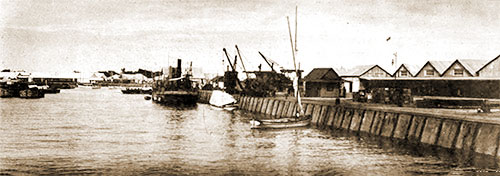
Customs Wharf and Wareshouses at the Port of Biera circa 1907. GGA Image ID # 141abaf11e
Passenger Lists available from the GG Archives from the Port of Beira, Mozambique. Organized by Date of Departure, Steamship Line, Steamship or Ocean Liner, Class of Passengers, Route, and the Ship's Captain.
Beira is the second largest city in Mozambique. Beira was originally developed by the Portuguese Mozambique Company in the 19th century, and directly developed by the Portuguese colonial government from 1947 until Mozambique gained its independence from Portugal in 1975.
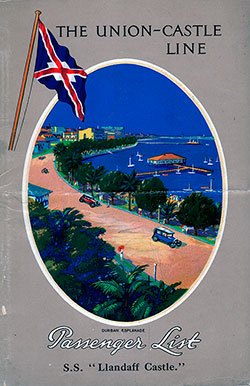
1929-05-23 SS Llandaff Castle Passenger List
- Steamship Line: Union-Castle Line
- Class of Passengers: First Class
- Date of Departure: 23 May 1929
- Route: London to South Africa via the Mediterranean
- Ports of Call: London to Natal via Marseilles, Genoa, Port Said, Port Sudan, Aden, Mombasa, Tanga, Zanzibar, DarEs-Salaam, Port Amelia, Beira and Lourenço Marques (Maputo)
- Commander: Captain E. F. Gilbert

1937-07-21 SS City of New York Passenger List
- Steamship Line: American South African Line
- Class of Passengers: Cabin
- Date of Departure: 21 July 1937
- Route: Beira to New York via Lindi, Dar-Es-Salaam, Zanzibar, Tanga, Mombasa, Durban, Port Elizabeth, Capetown, and the Island of Trinidad
- Commander: Captain C. W. Schmidt, Lt. Cmdr. USNR
As to the port of Beira itself, it is equipped with four distinct landing-places for the discharge of cargo:
- The Mozambique Company's wharf, at which general merchandise, whether for delivery within Portuguese territory or for transit to Rhodesia, is landed. This wharf is equipped with cranes and tram lines.
- The No. 1 Pier, at the mouth of the Pungwe River on the opposite side of the Chiveve Creek, used chiefly for the railway's own stores and construction material. This pier is connected with the railway by a leading line of rails running throughout its length, with double spurs at the T head, and it is at present provided with a five-ton crane.
- The No. 2 Pier—a spacious landing stage, equipped with five-ton and fifteen-ton cranes, and four lines of rails.
- A foot jetty used only for the landing of dynamite and timber. Ships are loaded or discharged at the above landing-places by lighters, which can lie alongside the wharf and the No. 1 Pier at all states of the tide; the No. 2 Pier and the jetty are not accessible at low tide.
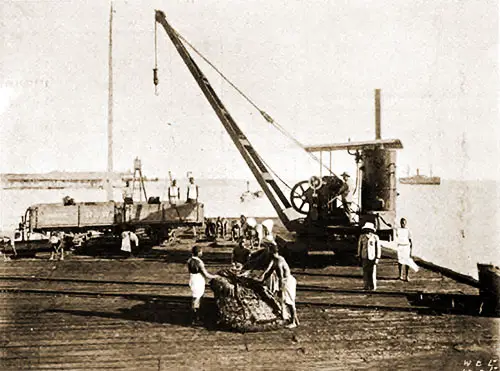
The No. 1 Pier at Beira circa 1907. GGA Image ID # 141adf98ec
With the existing accommodation ships have been discharged at the rate of 400 to 500 tons a day, and it is estimated that, without adding to these facilities, cargoes could be easily dealt with, if the occasion arose, at double that rate—say from 900 to 1,000 tons a day. The anchorage for ships at Beira is excellent.
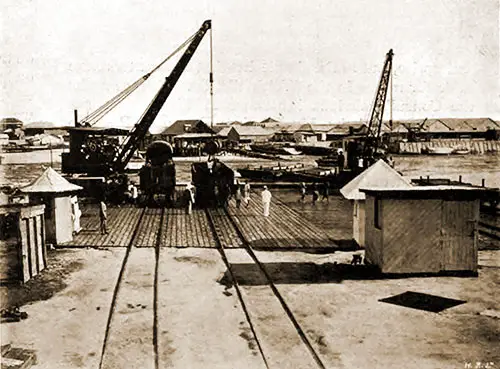
No, 2 Pier at Beira circa 1907. GGA Image ID # 141aeae2bf

Customs Wharf and Warehouses at the Port of Beira circa 1907. GGA Image ID # 141aeb40e0
On the wharf stand the spacious Customs House and the warehouses erected by the Mozambique Company.
Goods destined for transport by rail after passing through the Customs House are at present conveyed by trolley across the Chiveve Creek bridge to the railway station yard, and there loaded into goods trains which leave daily for the interior.
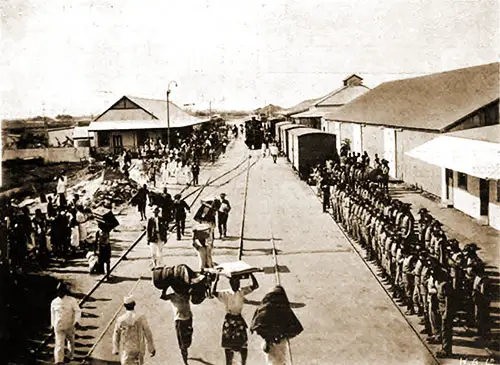
Beira Railway Station and Goods Warehoues circa 1907. GGA Image ID # 141af7d86f
Goods in transit for Rhodesia are conveyed in covered trucks officially sealed--the seal not being broken until the trucks have passed out of Portuguese territory. The Rhodesian Customs duty on goods destined for Rhodesia can now be paid if desired at Beira, a Customs House for the purpose having recently been opened in the railway station yard for the convenience, and at the request, of Rhodesian merchants.
Some thirteen lines of steamships regularly call at the port, and statistics show that the number of vessels, ocean and coasting, so calling has increased rapidly in recent years, and is still steadily growing.
The Mozambique Company is largely extending its warehouse accommodation and is constructing over the Chiveve Creek a new steel bridge capable of meeting the present traffic and allowing for future developments.
The Beira and Mashonaland Railways, too, are leading the way in what is a new departure for South Africa, namely, the system of through bills of lading from English towns to stations in Rhodesia, an agency for that purpose having been accepted by a leading firm of London shipping agents.
When the arrangements have been completed, British merchants will be able to ascertain and defray in advance the whole of the transport charges ocean, rail and forwarding—-on their shipments from their own warehouses to the Rhodesian town to which they are consigned.
The passenger traffic is well looked after, the trains from the port to the inland centers being composed of carriages fitted up in a luxurious manner, dining cars, wherein meals and light refreshments are supplied at moderate charges, being provided.
